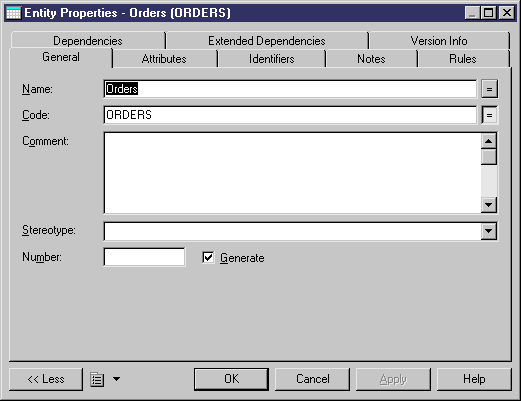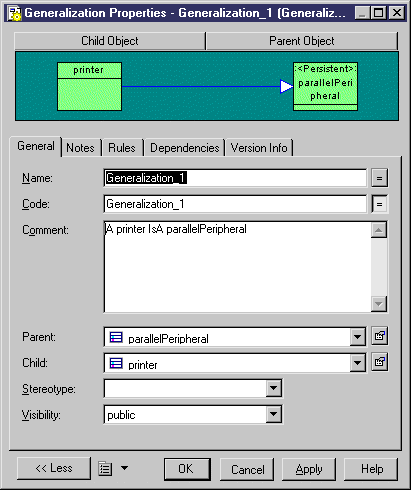

Chapter 3 Getting Started with the PowerDesigner Eclipse Plugin
Working with property sheets
All model objects created in PowerDesigner have property sheets.

Property sheets allow you to assign extensive and sophisticated properties to objects. Most PowerDesigner objects have the following properties, but note that many other properties will be available, depending on the type of object:
- Name: the name of the object, which should be clear and meaningful, and should convey the object's purpose to non-technical users
- Code: the technical name of the object, which is used for generating code or scripts, which may be abbreviated, and should not generally include spaces
- Comment: an optional description of the object, which can be used to provide further information.
- Notes (on the Notes Tab) are made up of Descriptions, which provide detailed information about the object, and Annotations, which contain your own notes regarding the implementation of the object
- Rules (on the Rules tab) that your business follows. A business rule could be a government-imposed law, a customer requirement, or an internal guideline
- Version Information (on the Version Info tab) provides details about the object owner, creation, and modification date
- Dependencies (on the Dependencies tab) list all objects depending on the current object
- Extended Dependencies (on the Extended Dependencies tab) list all objects which collaborate with the current object
Opening a property sheet
 To open a property sheet:
To open a property sheet:
- Double-click the object symbol in the diagram.
or
Right-click the object symbol in the diagram and select Properties.
or
Right-click the object name in the Model Explorer and select Properties.
or
Double-click any label (name, code, role or cardinality) of a linking object in the diagram.
The property sheet opens to the General tab. In the case of a link object, a graphical representation of the link with its source and destination objects points is displayed in the upper part of the dialog box.

Specifying object properties
Property sheets behave like standard dialog boxes, and allow you to perform all the usual actions, such as typing and editing text in boxes, selecting check boxes, and selecting values in lists.
Once you have defined or modified any properties, you can click Apply to commit any changes and continue, or OK to commit any changes and close the property sheet. Click Cancel if you want to discard any changes made.
Customizing a property sheet
Since PowerDesigner property sheets can contain such a large, diverse amount of information, you may want to customize their display via the Customize Property Sheet dropdown menu in the bottom-left corner. This menu gives you the following options:
| Command
|
Description
|
|---|
| Display Standard Pages
|
Displays a minimum number of tabs or the tabs that you have defined as standard in the Customize Standard Pages dialog box
|
| Display All Pages
|
Displays all available tabs
|
| Customize
|
Allows you to define standard tabs
|
Any changes in the display options of property pages are immediately applied to the current property sheet and become the default settings for any property sheet of the same type that you subsequently open.
|
Copyright (C) 2007. Sybase Inc. All rights reserved.
|

|



![]() To open a property sheet:
To open a property sheet:
